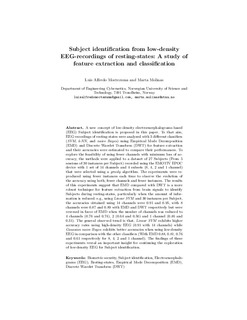| dc.contributor.author | Moctezuma, Luis Alfredo | |
| dc.contributor.author | Molinas Cabrera, Maria Marta | |
| dc.date.accessioned | 2019-05-13T08:53:58Z | |
| dc.date.available | 2019-05-13T08:53:58Z | |
| dc.date.created | 2019-02-04T15:49:53Z | |
| dc.date.issued | 2019 | |
| dc.identifier.citation | Lecture Notes in Networks and Systems. 2020, 70 830-846. | nb_NO |
| dc.identifier.issn | 2367-3370 | |
| dc.identifier.uri | http://hdl.handle.net/11250/2597357 | |
| dc.description.abstract | A new concept of low-density electroencephalograms-based (EEG) Subject identification is proposed in this paper. To that aim, EEG recordings of resting-states were analyzed with 3 different classifiers (SVM, k-NN, and naive Bayes) using Empirical Mode Decomposition (EMD) and Discrete Wavelet Transform (DWT) for feature extraction and their accuracies were estimated to compare their performances. To explore the feasibility of using fewer channels with minimum loss of accuracy, the methods were applied to a dataset of 27 Subjects (From 5 sessions of 30 instances per Subject) recorded using the EMOTIV EPOC device with 1 set of 14 channels and 4 subsets (8, 4, 2 and 1 channel) that were selected using a greedy algorithm. The experiments were reproduced using fewer instances each time to observe the evolution of the accuracy using both; fewer channels and fewer instances. The results of this experiments suggest that EMD compared with DWT is a more robust technique for feature extraction from brain signals to identify Subjects during resting-states, particularly when the amount of information is reduced: e.g., using Linear SVM and 30 instances per Subject, the accuracies obtained using 14 channels were 0.91 and 0.95, with 8 channels were 0.87 and 0.89 with EMD and DWT repectively but were reversed in favor of EMD when the number of channels was reduced to 4 channels (0.76 and 0.74), 2 (0.64 and 0.56) and 1 channel (0.46 and 0.31). The general observed trend is that, Linear SVM exhibits higher accuracy rates using high-density EEG (0.91 with 14 channels) while Gaussian naive Bayes exhibits better accuracies when using low-density EEG in comparison with the other classifiers (with EMD 0.88, 0.81, 0.76 and 0.61 respectively for 8, 4, 2 and 1 channel). The findings of these experiments reveal an important insight for continuing the exploration of low-density EEG for Subject identification. | nb_NO |
| dc.language.iso | eng | nb_NO |
| dc.publisher | Springer Verlag | nb_NO |
| dc.title | Subject Identification from Low-Density EEG-Recordings of Resting-States: A Study of Feature Extraction and Classification | nb_NO |
| dc.type | Journal article | nb_NO |
| dc.type | Peer reviewed | nb_NO |
| dc.description.version | acceptedVersion | nb_NO |
| dc.source.pagenumber | 830-846 | nb_NO |
| dc.source.volume | 70 | nb_NO |
| dc.source.journal | Lecture Notes in Networks and Systems | nb_NO |
| dc.identifier.doi | 10.1007/978-3-030-12385-7_57 | |
| dc.identifier.cristin | 1673241 | |
| dc.description.localcode | This is a post-peer-review, pre-copyedit version of an article published in [Lecture Notes in Networks and Systems] Locked until 2.2.2020 due to copyright restrictions. The final authenticated version is available online at: https://doi.org/10.1007/978-3-030-12385-7_57 | nb_NO |
| cristin.unitcode | 194,63,25,0 | |
| cristin.unitname | Institutt for teknisk kybernetikk | |
| cristin.ispublished | true | |
| cristin.fulltext | preprint | |
